
- Home
- Travel Packages
- Top Destination
-
Travel Attraction
By Category
Top Attraction

- Travel Agents
- Car Rentals
- Hotels
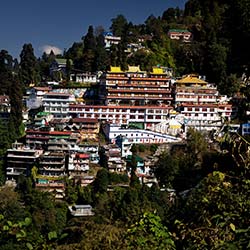
About Dali Monastery The Dali Monastery, located in Darjeeling, is a prominent Tibetan Buddhist monastery known for its stunning architecture and serene surroundings. It was built in the early 1970s and serves as a place of worship, learning, and meditation for the local Buddhist community. The monastery is dedicated to the Dali Lama, the spiritual leader of Tibetan Buddhism, and is a must-visit destination for those seeking spiritual enlightenment and inner peace. History, Architecture, and Design The Dali Monastery is a beautiful example of traditional Tibetan architecture, with its colorful prayer flags, intricate wood carvings, and golden roof. The monastery's design reflects the rich cultural heritage of Tibetan Buddhism, with its ornate temples, prayer halls, and meditation rooms. Visitors can admire the stunning frescoes, statues, and thangka paintings that adorn the monastery's walls, depicting various Buddhist deities and symbols. The monastery's peaceful atmosphere and breathtaking views of the surrounding mountains make it a truly special place to visit. Best Time to Visit The best time to visit the Dali Monastery is during the spring and autumn months, when the weather is mild and the skies are clear. This is the perfect time to explore the monastery's grounds, participate in meditation sessions, and witness traditional Buddhist ceremonies. Additionally, the annual Dali Lama's birthday celebration, held in July, is a major event at the monastery and a great opportunity to experience the local culture and traditions. Cultural Significance The Dali Monastery holds great cultural significance for the Tibetan Buddhist community in Darjeeling. It serves as a vital center for religious teachings, rituals, and ceremonies, and plays a key role in preserving and promoting Tibetan Buddhist culture and traditions. The monastery's monks are highly respected for their knowledge, wisdom, and compassion, and are revered by the local community for their dedication to spiritual practice and service to others. Pilgrimage Practices Visitors to the Dali Monastery can participate in various pilgrimage practices, such as circumambulating the monastery's prayer wheels, offering prayers and offerings at the shrines, and receiving blessings from the resident monks. Pilgrims are encouraged to cultivate mindfulness, compassion, and gratitude during their visit, and to reflect on the teachings of the Buddha as they explore the monastery's sacred spaces. Dress Code and Etiquette Visitors to the Dali Monastery are expected to dress modestly and respectfully, covering their shoulders and knees and removing their shoes before entering the temple grounds. It is important to observe silence and mindfulness while on the monastery's premises, and to show reverence and humility towards the resident monks and other worshippers. Photography is allowed in certain areas of the monastery, but it is important to ask for permission before taking photos of the monks or sacred objects. Activities and Experiences Visitors to the Dali Monastery can participate in a variety of activities and experiences, such as attending meditation sessions, participating in chanting ceremonies, and receiving teachings from the resident monks. The monastery also offers classes in Tibetan Buddhism, meditation, and traditional arts and crafts, providing visitors with a unique opportunity to deepen their spiritual practice and expand their cultural knowledge. Art and Religious Symbols The Dali Monastery is adorned with a wealth of beautiful art and religious symbols, including thangka paintings, mandalas, and statues of Buddha and various deities. These artistic creations serve as powerful teaching tools, conveying the wisdom and compassion of the Buddha and inspiring devotion and contemplation in the hearts of the faithful. Visitors can learn about the symbolism and significance of these sacred artworks by participating in guided tours and workshops offered at the monastery. Local Insights Exploring the Dali Monastery with a local guide can provide valuable insights into the history, culture, and spiritual practices of the Tibetan Buddhist community in Darjeeling. Local guides can offer a deeper understanding of the monastery's architecture, art, and rituals, as well as share personal anecdotes and stories about their own experiences at the monastery. Engaging with the local community through interactions with monks, pilgrims, and artisans can also enrich visitors' understanding of Tibetan Buddhist culture and strengthen their connection to the spiritual essence of the Dali Monastery.
Explore More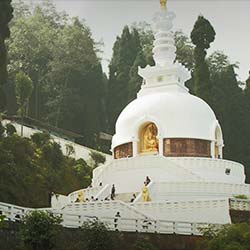
About Peace Pagoda, Darjeeling History The Peace Pagoda in Darjeeling was built under the guidance of Nichidatsu Fujii, a Japanese Buddhist monk, as a symbol of peace and harmony. It was inaugurated in 1992 by the Dalai Lama. The pagoda serves as a testament to the enduring friendship between India and Japan. Architecture and Design The Peace Pagoda follows traditional Japanese architectural style with its white dome and golden spire. The structure is adorned with intricate carvings and statues of Buddha, depicting various stages of his life. The pagoda stands tall amidst lush greenery, offering a serene and tranquil atmosphere to visitors. Best Time to Visit The best time to visit the Peace Pagoda in Darjeeling is during the months of March to May and September to November when the weather is pleasant and favorable for sightseeing. Avoid visiting during the monsoon season as heavy rainfall may disrupt your plans. Cultural Significance The Peace Pagoda is a symbol of peace, unity, and universal brotherhood. It serves as a place for people of all backgrounds to come together in prayer and meditation, promoting harmony and understanding among different cultures and communities. Pilgrimage Practices Visitors to the Peace Pagoda can engage in traditional Buddhist practices such as offering prayers, lighting incense sticks, and spinning prayer wheels for good luck and blessings. It is important to maintain silence and respect the religious customs observed by the monks and devotees. Dress Code and Etiquette While visiting the Peace Pagoda, it is advisable to dress modestly and conservatively out of respect for the sacredness of the place. Remove your shoes before entering the pagoda and maintain a quiet demeanor to not disturb the peaceful ambiance. Activities and Experiences At the Peace Pagoda, visitors can participate in meditation sessions, yoga classes, and spiritual talks conducted by the resident monks. You can also enjoy panoramic views of the surrounding mountains and valleys, making it a perfect spot for photography and introspection. Art and Religious Symbols The Peace Pagoda is adorned with intricate paintings, sculptures, and religious symbols that reflect the teachings and philosophies of Buddhism. The statues of Buddha and other deities serve as objects of reverence and inspiration for those seeking spiritual enlightenment. Local Insights The local community in Darjeeling holds the Peace Pagoda in high regard, considering it a sacred place of worship and contemplation. They actively participate in the upkeep and maintenance of the pagoda, ensuring that it remains a beacon of peace and harmony for generations to come.
Explore More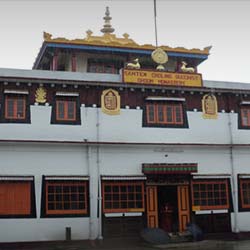
About Ghum Monastery Ghum Monastery, also known as Yiga Choeling Monastery, is a prominent Buddhist monastery located in Ghum, Darjeeling. It is one of the oldest Tibetan Buddhist monasteries in the region and holds great cultural and spiritual significance. The monastery is known for its stunning architecture and rich history, making it a popular tourist attraction in Darjeeling. History, Architecture and Design Ghum Monastery was established in 1850 by Lama Sherab Gyatso, a monk from Tibet. The monastery's architecture reflects traditional Tibetan design, with intricate paintings, sculptures, and prayer wheels adorning its walls. The main attraction of the monastery is a 15-foot high statue of Maitreya Buddha, believed to be one of the largest of its kind in the region. Best Time to Visit The best time to visit Ghum Monastery is during the months of March to May and September to November when the weather is pleasant and ideal for sightseeing. Avoid visiting during the monsoon season as heavy rainfall can disrupt your travel plans. Cultural Significance Ghum Monastery holds immense cultural significance for the Tibetan community in Darjeeling. It serves as a center for Buddhist teachings, meditation, and spiritual practices. The monastery also hosts various cultural events and festivals throughout the year, attracting devotees and tourists alike. Pilgrimage Practices Visitors to Ghum Monastery are encouraged to participate in the daily rituals and practices observed by the resident monks. This includes attending morning prayers, meditation sessions, and offerings to the Buddha. Pilgrims can also seek blessings from the monks and receive spiritual guidance during their visit. Dress Code and Etiquette When visiting Ghum Monastery, it is important to dress modestly and respectfully. Both men and women should wear clothing that covers their shoulders and knees out of respect for the Buddhist traditions. It is also customary to remove your shoes before entering the monastery and to maintain a quiet and respectful demeanor during your visit. Activities and Experiences Visitors to Ghum Monastery can partake in various activities and experiences, including guided tours of the monastery, attending meditation classes, and participating in cultural workshops. You can also explore the surrounding area on foot, taking in the serene beauty of the Himalayan landscape and interacting with the local community. Art and Religious Symbols The interior of Ghum Monastery is adorned with exquisite paintings, murals, and religious symbols that tell the story of Tibetan Buddhism. The intricate artwork and sculptures depict scenes from Buddhist mythology and teachings, creating a peaceful and meditative atmosphere for visitors. Local Insights For a deeper understanding of Ghum Monastery and its significance, consider engaging with the local community and monks. They can provide insights into the monastery's history, daily practices, and cultural traditions, giving you a unique perspective on Tibetan Buddhism and the spiritual life of the region.
Explore More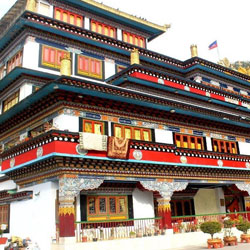
About the Buddhist Monastery, Darjeeling History The Buddhist Monastery in Darjeeling, also known as the Yiga Choeling Monastery, was established in 1850 by Lama Dorje Rinzing. It is one of the oldest monasteries in the region and holds significant historical importance in the development of Buddhism in Darjeeling. Architecture and Design The monastery features traditional Tibetan architecture, with colorful prayer flags adorning the exterior. The main prayer hall is adorned with intricate paintings and sculptures depicting Buddhist deities and symbols. The design of the monastery reflects the rich cultural heritage of the Tibetan Buddhist tradition. Best Time to Visit The best time to visit the Buddhist Monastery in Darjeeling is during the months of September to December when the weather is pleasant and clear, offering stunning views of the surrounding Himalayan mountains. It is also a great time to witness local festivals and religious ceremonies at the monastery. Cultural Significance The monastery plays a vital role in preserving and promoting Tibetan Buddhist culture and traditions in Darjeeling. It serves as a spiritual center for the local community and attracts pilgrims and visitors from around the world who seek spiritual guidance and enlightenment. Pilgrimage Practices Pilgrims visiting the monastery often engage in traditional Buddhist practices such as offering prayers, lighting butter lamps, and spinning prayer wheels. These practices are believed to accumulate merit and bring blessings to the devotees. Dress Code and Etiquette Visitors are advised to dress modestly and remove their shoes before entering the monastery. It is important to show respect for the monks and the sacred artifacts within the monastery by maintaining a quiet and peaceful demeanor during your visit. Activities and Experiences Visitors can participate in meditation sessions, attend teachings by Buddhist monks, and explore the monastery's library and museum. Taking part in these activities allows visitors to deepen their understanding of Tibetan Buddhist philosophy and practices. Art and Religious Symbols The monastery is adorned with vibrant thangka paintings, intricate mandalas, and statues of Buddha and other deities. These artistic expressions serve as visual representations of Buddhist teachings and help inspire devotion and contemplation among the worshippers. Local Insights Local residents often visit the monastery to seek blessings for prosperity and well-being. They participate in religious rituals and offer prayers for the well-being of their families and communities. The monastery serves as a spiritual sanctuary for the local population and a place of solace amidst the hustle and bustle of daily life in Darjeeling.
Explore More
About Ghoom Monastery The Ghoom Monastery, also known as the Yiga Choeling Monastery, is a renowned Buddhist monastery located in the town of Ghoom near Darjeeling, West Bengal, India. It was established in 1850 by Lama Sherab Gyatso and belongs to the Gelug school of Tibetan Buddhism. The monastery is famous for its impressive architecture and serene surroundings, attracting tourists and pilgrims from all over the world. History, Architecture, and Design The Ghoom Monastery has a rich history dating back to the mid-19th century. The monastery's architecture showcases traditional Tibetan design elements, with colorful frescoes, intricate wood carvings, and ornate statues adorning its interiors. The main highlight of the monastery is the 15-foot tall statue of Maitreya Buddha, believed to be one of the largest of its kind in the region. Best Time to Visit The best time to visit the Ghoom Monastery is during the months of October to December when the weather is pleasant and the monastery hosts various religious festivals and ceremonies. The early morning hours are ideal for witnessing the monks' prayer rituals and soaking in the peaceful ambiance of the monastery. Cultural Significance The Ghoom Monastery holds great cultural significance as a center of Buddhist learning and practice. It serves as a spiritual retreat for monks and visitors seeking tranquility and enlightenment. The monastery's teachings and rituals reflect the essence of Tibetan Buddhism, promoting peace, compassion, and mindfulness. Pilgrimage Practices Pilgrims visiting the Ghoom Monastery engage in traditional Buddhist practices such as prostrations, chanting mantras, and offering prayers to the Buddha. They seek blessings from the resident lamas and participate in meditation sessions to deepen their spiritual connection and inner peace. Dress Code and Etiquette Visitors to the Ghoom Monastery are expected to dress modestly and respectfully, covering their shoulders and legs. Shoes must be removed before entering the prayer halls, and photography is usually not allowed inside the monastery to maintain the sanctity of the religious space. Silence and mindfulness are encouraged to uphold the serene atmosphere of the monastery. Activities and Experiences Visitors to the Ghoom Monastery can participate in guided tours, meditation sessions, and cultural programs organized by the resident monks. They can explore the monastery's library, art collection, and gift shop to learn more about Tibetan Buddhism and purchase souvenirs. Trekking and nature walks in the surrounding Himalayan landscapes are also popular activities for tourists. Art and Religious Symbols The Ghoom Monastery is adorned with intricate Buddhist art and religious symbols that convey profound spiritual meanings. The colorful thangka paintings, symbolic mandalas, and sacred statues depict the life of the Buddha, the Wheel of Dharma, and other revered deities in Tibetan Buddhism. These artistic creations serve as visual aids for meditation and contemplation. Local Insights Local residents near the Ghoom Monastery are predominantly Tibetan and Nepali, practicing a blend of Buddhist and Hindu traditions. They warmly welcome visitors and offer insights into their cultural heritage, cuisine, and lifestyle. Exploring the nearby markets and tea gardens allows tourists to experience the vibrant local community and savor authentic flavors of Darjeeling. In conclusion, the Ghoom Monastery in Darjeeling stands as a spiritual sanctuary and cultural gem that invites travelers to immerse themselves in the wisdom and tranquility of Tibetan Buddhism. Its historical roots, architectural beauty, and religious practices make it a must-visit destination for those seeking spiritual enlightenment and cultural enrichment.
Explore More
About Zang Dhok Palri Phodang, Kalimpong History Zang Dhok Palri Phodang is a Buddhist monastery located in Kalimpong, West Bengal. It was consecrated by His Holiness the Dalai Lama in 1976 and is one of the most important monasteries in the region. The name "Zang Dhok Palri Phodang" translates to "Heavenly Abode of Guru Padmasambhava" in Tibetan. The monastery is built in traditional Tibetan style and is a place of great spiritual significance for Buddhists. Architecture and Design The architecture of Zang Dhok Palri Phodang is a beautiful blend of traditional Tibetan and Bhutanese styles. The main building is adorned with intricate carvings and colorful frescoes depicting Buddhist deities and symbols. The monastery is surrounded by lush greenery and offers stunning views of the Himalayan mountains. The design of the monastery reflects the rich cultural heritage of the Tibetan people and is a sight to behold for visitors. Best Time to Visit The best time to visit Zang Dhok Palri Phodang is during the months of September to December when the weather is pleasant and the skies are clear. This is also the time when the monastery hosts various festivals and events, making it a great opportunity to witness traditional Buddhist rituals and ceremonies. Cultural Significance Zang Dhok Palri Phodang is a place of great cultural significance for Buddhists as it is believed to be the abode of Guru Padmasambhava, a revered figure in Tibetan Buddhism. The monastery is a center for spiritual practice and meditation, drawing pilgrims and visitors from all over the world who seek spiritual enlightenment and inner peace. Pilgrimage Practices Visitors to Zang Dhok Palri Phodang are encouraged to participate in the daily prayers and rituals performed by the monks. Pilgrims can also circumambulate the monastery in a clockwise direction as a form of devotion and purification. It is believed that by engaging in these practices, one can accumulate merit and blessings for oneself and others. Dress Code and Etiquette When visiting Zang Dhok Palri Phodang, it is important to dress modestly and respectfully. Women are advised to wear long skirts or pants and cover their shoulders, while men should wear long pants and shirts with sleeves. Visitors should also remove their shoes before entering the monastery and maintain a respectful silence during prayers and ceremonies. Activities and Experiences Visitors to Zang Dhok Palri Phodang can participate in meditation sessions led by the resident monks, attend teachings on Buddhist philosophy, and explore the beautiful grounds of the monastery. The surrounding area offers opportunities for hiking, birdwatching, and enjoying the serene beauty of the Himalayan landscape. Art and Religious Symbols The monastery is adorned with exquisite Buddhist art and religious symbols, including thangka paintings, statues of Buddhist deities, and intricate mandalas. These artworks serve as objects of devotion and contemplation for practitioners and visitors alike, inspiring a sense of peace and tranquility. Local Insights Local residents of Kalimpong hold Zang Dhok Palri Phodang in high regard and often visit the monastery to seek blessings and guidance from the resident lamas. The monastery plays a central role in the spiritual and cultural life of the community, hosting various events and festivals that bring people together in celebration and prayer.
Explore More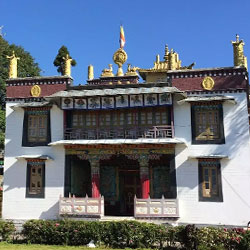
About Tharpa Choling Monastery History, Architecture, and Design Tharpa Choling Monastery, located in Kalimpong, is a historic Buddhist monastery that was founded in 1912 by Domo Geshe Rinpoche Ngawang Kalsang. The monastery is known for its stunning architecture and intricate designs, showcasing traditional Tibetan influences. The main prayer hall is adorned with colorful murals, ancient statues, and ornate carvings, creating a serene and spiritual ambiance for visitors. Best Time to Visit The best time to visit Tharpa Choling Monastery is during the months of March to May and September to November when the weather is pleasant and there are fewer crowds. These months offer clear views of the surrounding mountains and valleys, making it an ideal time for sightseeing and spiritual reflection. Cultural Significance Tharpa Choling Monastery holds significant cultural importance as a center for Buddhist teachings and practices. It is a place where monks and devotees come together to meditate, pray, and engage in religious rituals. The monastery also hosts various cultural events, festivals, and ceremonies throughout the year, showcasing traditional Tibetan customs and beliefs. Pilgrimage Practices Pilgrims from far and wide travel to Tharpa Choling Monastery to pay their respects to the Buddha and seek blessings from the resident monks. Pilgrimage practices often involve circumambulating the main prayer hall, offering prayers and offerings to the deity, and receiving blessings from the monastery's spiritual leaders. These practices are believed to purify the mind and accumulate positive karma. Dress Code and Etiquette Visitors to Tharpa Choling Monastery are expected to dress modestly and respectfully, covering arms and legs to show reverence for the sacred space. It is customary to remove shoes before entering the prayer halls and to maintain a quiet and reverent demeanor while inside. Photography may be restricted in certain areas, so it is important to ask for permission before taking any photos. Activities and Experiences Visitors to Tharpa Choling Monastery can participate in a variety of activities and experiences, including guided tours, meditation sessions, and teachings by resident monks. The monastery also offers opportunities for volunteering, such as helping with maintenance, gardening, or community outreach programs. Visitors can immerse themselves in the monastery's tranquil surroundings and engage in spiritual practices for personal growth and reflection. Art and Religious Symbols Tharpa Choling Monastery is adorned with beautiful artworks and religious symbols that hold deep spiritual significance for Buddhist practitioners. The monastery's architecture incorporates intricate mandalas, thangkas, and statues of Buddhas, bodhisattvas, and other deities, each representing different aspects of enlightenment and compassion. These artistic expressions serve as visual aids for meditation and contemplation, inspiring devotion and inner transformation. Local Insights Visitors to Tharpa Choling Monastery can gain valuable insights into Tibetan culture, history, and spiritual traditions by interacting with the resident monks and local community members. The monastery serves as a hub for preserving and promoting Tibetan Buddhist teachings, as well as fostering cultural exchange and understanding among visitors from diverse backgrounds. By engaging with the local community, visitors can deepen their appreciation for the rich heritage and living traditions of the Himalayan region.
Explore More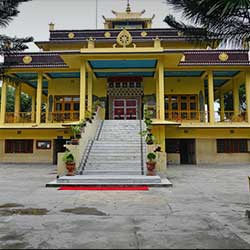
About Salugara Monastery History Located in Siliguri, West Bengal, the Salugara Monastery was established in 1960 by Tibetan monks fleeing Chinese oppression. The monastery serves as a spiritual refuge for Buddhist followers and has since become a popular pilgrimage site for both locals and tourists alike. Architecture and Design The Salugara Monastery is characterized by traditional Tibetan architecture, with vibrant colors and intricate designs adorning its exterior. The main prayer hall is adorned with statues of revered deities and intricate thangka paintings, creating a serene and meditative atmosphere for worshippers. Best Time to Visit The best time to visit the Salugara Monastery is during the annual Tibetan New Year celebrations, known as Losar, which usually falls in February or March. During this time, the monastery is adorned with colorful prayer flags and locals come together to participate in traditional ceremonies and rituals. Cultural Significance The Salugara Monastery holds immense cultural significance for the Tibetan community in exile, serving as a symbol of resilience and spiritual strength in the face of adversity. Visitors can experience the rich Tibetan culture through traditional ceremonies, chants, and rituals performed at the monastery. Pilgrimage Practices Pilgrims visiting the Salugara Monastery often engage in prostrations, circumambulations, and offering of prayers and butter lamps as part of their spiritual practice. These practices are believed to purify the mind and create positive energy, fostering a sense of inner peace and spiritual connection. Dress Code and Etiquette Visitors to the Salugara Monastery are expected to dress modestly and respectfully, covering their shoulders and knees when entering the premises. It is also customary to remove shoes before entering the prayer hall and to refrain from loud talking or disruptive behavior out of respect for the monks and worshippers. Activities and Experiences Visitors to the Salugara Monastery can participate in meditation sessions, attend teachings and workshops on Buddhist philosophy, and explore the surrounding gardens and stupas. The monastery also hosts cultural events, such as traditional dance performances and art exhibitions, providing a well-rounded spiritual and cultural experience. Art and Religious Symbols The Salugara Monastery is adorned with intricate murals, statues, and thangka paintings depicting various Buddhist deities, symbols, and teachings. These artistic representations serve as visual aids for meditation and contemplation, offering worshippers a deeper connection to the spiritual world. Local Insights Local residents of Siliguri often visit the Salugara Monastery to seek blessings, participate in prayers, and offer donations to support the monks and their community. Many locals also volunteer at the monastery, helping with maintenance, gardening, and organizing events to preserve and promote Tibetan culture and spirituality.
Explore More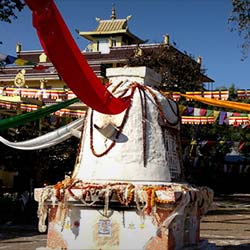
About Sed-Gyued Monastery Sed-Gyued Monastery, located in Siliguri, is a prominent Tibetan Buddhist monastery known for its serene ambiance and spiritual significance. Established in the early 20th century, the monastery attracts visitors with its rich history, intricate architecture, and profound cultural heritage. History, Architecture and Design The Sed-Gyued Monastery was founded by the Tibetan Buddhist community in exile, seeking refuge in India. The monastery's architecture reflects traditional Tibetan designs, with colorful murals, intricate woodwork, and ornate statues adorning the prayer halls. The main shrine of the monastery houses a sacred statue of Buddha, surrounded by prayer wheels and butter lamps. Best Time to Visit The best time to visit the Sed-Gyued Monastery is during the Tibetan New Year celebrations, known as Losar, which usually falls in February or March. This festive period offers a glimpse into Tibetan culture and traditions, with colorful rituals, masked dances, and traditional music performances. Cultural Significance The Sed-Gyued Monastery holds immense cultural significance as a center for Tibetan Buddhism in India. It serves as a place of worship, meditation, and education for the Tibetan community, preserving their spiritual heritage and teachings for future generations. Pilgrimage Practices Pilgrims visiting the Sed-Gyued Monastery often participate in prayer ceremonies, prostration rituals, and meditation sessions to deepen their spiritual connection. The monastery's peaceful surroundings and spiritual aura create a conducive environment for self-reflection and introspection. Dress Code and Etiquette Visitors to the Sed-Gyued Monastery are advised to dress modestly and respectfully, covering shoulders and knees. Removing shoes before entering prayer halls and refraining from loud noises or disruptive behavior are common etiquette practices observed at the monastery. Activities and Experiences Visitors to the Sed-Gyued Monastery can engage in a variety of activities and experiences, including attending teachings by resident monks, participating in guided meditation sessions, exploring the monastery's art and artifacts, and interacting with the local community to gain insights into Tibetan culture. Art and Religious Symbols The Sed-Gyued Monastery is adorned with intricate artwork depicting Buddhist deities, mandalas, and religious symbols that carry deep spiritual meanings. The colorful thangka paintings, intricate thrones, and elaborate rituals reflect the monastery's devotion to preserving and propagating Tibetan Buddhist art and iconography. Local Insights Interacting with the local Tibetan community and monks at the Sed-Gyued Monastery offers visitors valuable insights into their daily practices, beliefs, and cultural traditions. Engaging in conversations, participating in community events, and supporting local artisans and businesses are ways to appreciate and contribute to the vibrant Tibetan culture in Siliguri.
Explore MoreDarjeeling - Pelling - Ravangla - Namchi 6 Days 5 Nights Tour
6 Days/ 5 Night
Ravangla - Darjeeling - Pelling - Namchi
3 Night Darjeeling - Kalimpong Tour
4 Days/ 3 Night
Darjeeling - Kalimpong
5 Night - 6 Days Sikkim Tour Package For - 4 Pax
6 Days/ 5 Night
Gangtok - Darjeeling
6 Night - 7 Days Sikkim Tour Package For - 5 Pax
7 Days/ 6 Night
Gangtok - Darjeeling - Namchi - Pelling